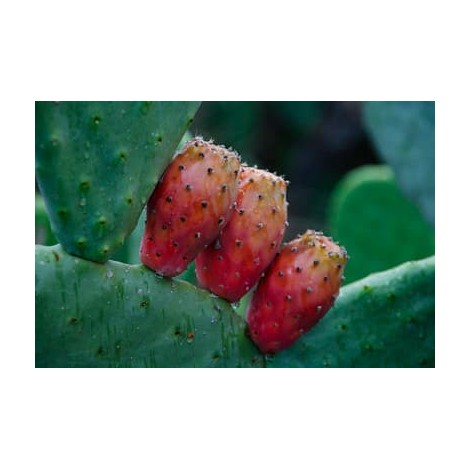





Jar of 8 units
The prickly pear, also known as pencas, is a surprising fruit from Mexico.
Behind its impressive spines, this unique fruit has a sweet core with an irresistibly smooth texture. From a nutritional standpoint, prickly pear has a few advantages that would be a shame to miss, starting with its vitamin C and dietary fiber content.
Nutritional and caloric values of prickly pear for 100g of prickly pear :
Nutrients
Average content
Water: Prickly pear is very rich in water, which makes it an ideal fruit for summer because of its refreshing and thirst-quenching properties;
Vitamin A: this vitamin contained in prickly pear allows a good renewal of body tissues;
Magnesium: prickly pear contributes to a good supply of magnesium, which will allow in particular to maintain the muscles, the nervous system and to participate in a good digestion;
Vitamin C: the vitamin C provided by prickly pear gives it good antioxidant properties, which will help fight against cellular aging.
Because of its atypical nutritional profile, the prickly pear is a health ally that deserves its place in the diet. Rich in fiber, it regulates transit and promotes digestive well-being. It is also rich in vitamin C and water, so it is appreciated for its moisturizing and antioxidant properties.
Regulates transit
Prickly pear provides a considerable amount of fiber, which facilitates intestinal transit and fights constipation.
Antioxidant
The vitamin C provided by prickly pear gives it antioxidant properties. It will allow a good cellular renewal for all body tissues.
Composed of a large amount of water, the prickly pear is a thirst-quenching fruit that perfectly complements a good hydration through drinking water to stay in shape.
To avoid digestive problems, it is recommended to remove the seeds contained in the prickly pear pulp before eating it. For information, a portion of prickly pear corresponds to approximately 100 g.
The prickly pear is a cactus fruit that grows mainly in the Mexican desert. It is said that this unique fruit was discovered by Christopher Columbus and imported to Europe after his explorations. The prickly pear is increasingly present in gourmet greengrocers, it can have a more or less elongated shape and its color varies according to the variety but our favorites are the purple or blood prickly pears.
Family: Cactus;
Origin: Mexico;
Season: August to October;
Color: orange red;
Taste: mild and sweet
Prickly pears are harvested on our farm between August and October. When ripe, they are orange in color and their skin is supple.
The weight of prickly pears varies greatly, ranging from 50 to 400 grams. The flesh can be yellow, red or even purple, which will slightly influence the taste of the prickly pear.
They can be stored at room temperature or on the vegetable shelf of the refrigerator for 2 to 3 days.
As the fruit has many thorns, it can be difficult to prepare it without hurting yourself. In this case, simply cut it in half and eat the flesh with a spoon. If you opt for an unpeeled prickly pear, just stick a fork into the fruit, make an incision with a knife on the top and bottom of the fruit, and then make an incision along the length of the fruit. All you have to do is gently remove the skin and enjoy the juicy flesh.
When tasted, it has a sweet, mild and slightly acidic flavor. Its water content makes this fruit very juicy and refreshing. In cooking, the prickly pear offers a multitude of possibilities and combines wonderfully well with both savory and sweet ingredients. This is a great advantage for this amazing fruit, which can easily be incorporated into all our favorite recipes.
Prickly pear can be eaten raw, in juice, in cake, in fruit paste or in jam. In jam, prickly pear can be combined with other fruits or with vanilla, with which it combines particularly well.
In my previous stage as an ice cream maker I made prickly pear sorbet ice cream with the purple variety, buttered with carob flour, sucrose, fructose and spring water and it was super creamy with a color so vivid that it seemed artificial.
If you want to learn how to make homemade ice cream with tropical fruits, you can contact us, minimum group of 4 people and one week in advance.
In Mexico, the prickly pear is cut into sticks to be roasted and eaten with meat. Fermented, the prickly pear is used to make tequila.
For the more adventurous, the prickly pear can also be cooked in a salted version. It can be cooked as a chutney or sauce to accompany white meats or game.
The major drawback of prickly pear is undoubtedly the presence of the numerous seeds contained in its pulp. Indeed, in sensitive subjects, these seeds can cause intestinal occlusions and aggravate diverticulosis when consumed in excess.
In subjects suffering from irritable bowel syndrome, the consumption of prickly pears must be adapted to digestive tolerance. Indeed, the fibers it contains can provoke unpleasant digestive symptoms: bloating, diarrhea, etc.
They are but the can cause intestinal obstructions. Care must be taken not to eat too much prickly pear, as its seeds can cause digestive problems, especially intestinal obstruction.
Widely consumed in Mexico, prickly pears from North Africa, Spain, Sardinia and Sicily can be found in stalls. The prickles on the prickly pear skin make harvesting long and difficult, which explains the rarity of this fruit.